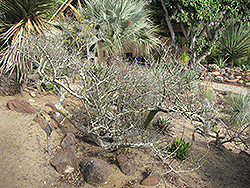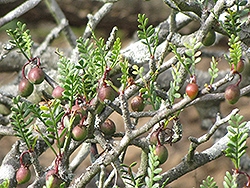It's all about ...
plants

Height: 10 feet
Spread: 10 feet
Sunlight:
![]()
Hardiness Zone: 9b
Other Names: Small-leaved Bursera, Torchwood
Description:
An interesting desert shrub, with a short, thick trunk that stores water, and peeling white bark; tiny foliage in a pinnate arrangement; low water needs; drought deciduous; great for rock gardens or containers
Ornamental Features
Elephant Tree has attractive dark green deciduous foliage on a plant with an upright spreading habit of growth. The tiny oval pinnately compound leaves are highly ornamental but do not develop any appreciable fall colour. The fruits are showy green drupes displayed in late summer. The peeling white bark is extremely showy and adds significant winter interest.
Landscape Attributes
Elephant Tree is a multi-stemmed deciduous shrub with an upright spreading habit of growth. Its average texture blends into the landscape, but can be balanced by one or two finer or coarser trees or shrubs for an effective composition.
This is a relatively low maintenance shrub, and may require the occasional pruning to look its best. It has no significant negative characteristics.
Elephant Tree is recommended for the following landscape applications;
- Accent
- Rock/Alpine Gardens
- General Garden Use
- Container Planting
Planting & Growing
Elephant Tree will grow to be about 10 feet tall at maturity, with a spread of 10 feet. It has a low canopy with a typical clearance of 1 foot from the ground, and is suitable for planting under power lines. It grows at a slow rate, and under ideal conditions can be expected to live for approximately 30 years.
This shrub should only be grown in full sunlight. It prefers dry to average moisture levels with very well-drained soil, and will often die in standing water. It is considered to be drought-tolerant, and thus makes an ideal choice for xeriscaping or the moisture-conserving landscape. It is not particular as to soil type or pH. It is somewhat tolerant of urban pollution. This species is not originally from North America.
Elephant Tree makes a fine choice for the outdoor landscape, but it is also well-suited for use in outdoor pots and containers. Its large size and upright habit of growth lend it for use as a solitary accent, or in a composition surrounded by smaller plants around the base and those that spill over the edges. It is even sizeable enough that it can be grown alone in a suitable container. Note that when grown in a container, it may not perform exactly as indicated on the tag - this is to be expected. Also note that when growing plants in outdoor containers and baskets, they may require more frequent waterings than they would in the yard or garden. Be aware that in our climate, most plants cannot be expected to survive the winter if left in containers outdoors, and this plant is no exception. Contact our experts for more information on how to protect it over the winter months.
This plant is not reliably hardy in our region, and certain restrictions may apply; contact the store for more information.

